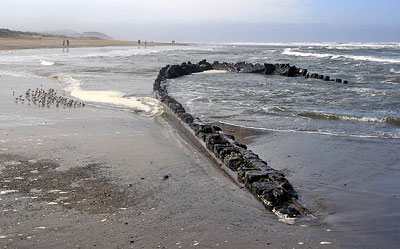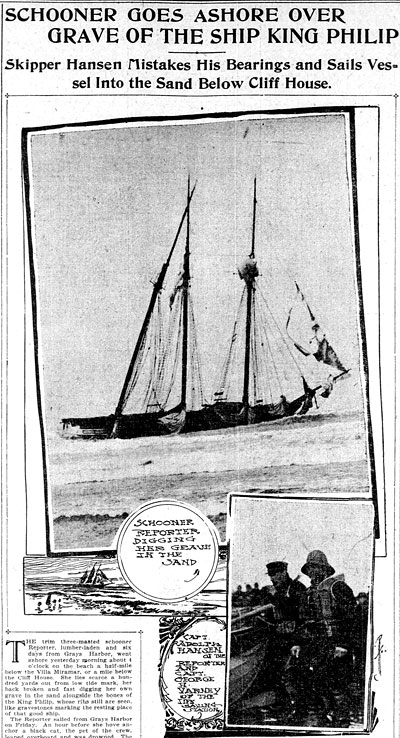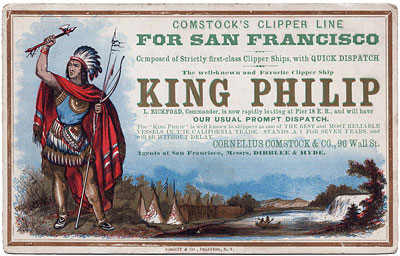National Register of Historic Places in San Francisco
 22 May 2011
22 May 2011
Photograph Courtesy Wikipedia
(Click Photo to Zoom)
The wreck of this ship is only rarely visible; very infrequently the timbers can be seen protruding from the sands of Ocean Beach.

From San Francisco Call Dated March 14, 1902
Cliff House Project
(Click Image to Zoom)
Shipwreck of the Clipper King Philip and the Schooner Reporter
Address Restricted
King Philip was built in Alna, Maine in 1856. With a wooden hull and three masts, she was a medium-sized clipper.
The ship carried cargo from the Eastern United States to San Francisco. The route required going around Cape Horn, which is famous for its enormous storms.
King Philip had a turbulent history, including at least two mutinies where the crew set her on fire. On January 25, 1878, 22 years after she was built, King Philip left San Francisco Bay carrying no cargo. A steam-powered tugboat had towed her out of the Bay to help her maneuver in the dangerous waters. At that exact moment, an accident caused the death of the captain of a ship that was nearby, and the tugboat crew was called upon to help out with that emergency. Left on her own without the tugboat to steer her, King Philip dropped anchor, but the anchor did not hold, and the clipper drifted with the current towards the breakers of the beach and ran aground in heavy surf, which caused the ship to break apart.
The Daily Alta California described the scene:
Left helpless, anchors gone, sails clewed up, no friendly breeze, no hope, the gallant craft strikes and strikes the sand as if in anger, but powerless, as the hard, cold beach starts her timbers, tears her rudder out, crushes her keel and mashes her stout timbers in matchwood....
All the members of the crew survived being so close to the sandy beach and dry land, but the clipper herself was a total loss.
The wrecked clipper was auctioned to a San Francisco businessman who salvaged metal fittings and sails.
The rest of the wreck was blown up and abandoned.

On the evening of March 13 Reporter neared the Golden Gate in a thick fog. In the dark, Capt. Adolph Hansen saw a strong light to starboard, which he took to be the lighthouse at Point Bonita. Allowing the vessel to drive ahead and pass the light to enter the Gate, Hansen found himself caught in the surf; "not until the schooner was in the breakers did he know he was trying to hurdle her over the peninsula instead of going in orderly through the harbor entrance." Hansen mistook a light at the Cliff House for Point Bonita Light, and "Reporter" struck Ocean Beach about three miles south of Point Lobos, beaching where the bark King Philip had gone ashore in 1878.
Heavy seas swept the decks, forcing the crew up into the rigging. The mizzen-mast fell, injuring one man who fell to the deck. Capt. Hansen had meanwhile flashed a light as a distress signal, alerting a surfman from the Golden Gate Life-Saving Station who was patrolling the beach. Rescuers soon arrived and launched a surfboat to retrieve the crew. The surfboat swamped on the first attempt, but on the second try the crew was saved. Waves gradually pushed Reporter up on the beach, and by daylight the ship lay on its starboard side a hundred yards from shore. "During the day she heaved and lurched until she was lying almost stern on." According to the San Francisco Examiner:
There is no hope for Reporter. Her cargo of lumber, worth $14,000, is likely to drift to the beach in parcels. It can be stacked and carted away into the city and so saved. The schooner can only fight till her tendons give. Her ribs and sheathing, masts and rails will wash ashore, to be carried away by thrifty seaside dwellers and be used as firewood.
The schooner was visited by Capt. Hansen and the life-savers the day after the wreck, and the chronometer and a few personal effects were saved. Thousands of San Francisco residents visited the wreck, "and not even the biting wind and sudden squalls could keep them away." Enterprising businessmen posted broadsides on the hulk, "Boise Liniment" for rheumatism. The keel broken, Reporter began to fall apart and disappear beneath the sand, "fast digging her own grave alongside the bones of the King Philip, whose ribs are still seen..."
From Shipwrecks at the Golden Gate by James Delgado and Stephen Haller (1989)

Left in place at extreme low tide level in 1878, what is left of the wreck of the King Philip is usually completely covered in sand. Sometimes, as the profile of the sand on the beach shifts and changes, the timbers reemerge and are visible during low tides. The wreck was partially visible when the schooner Reporter wrecked on the same site on March 13, 1902. Contemporary accounts noted that Reporter was "fast digging her own grave alongside the bones of the King Philip, whose ribs are still seen..." The wrecks of both ships were buried in 1910 when bulldozing of the sand dunes to build the Great Highway pushed large amounts of sand onto the beach.
In recent times, the was visible in 1982 and 1983. The wreck was exposed in May 1984 to a hitherto unseen degree, at which time a team determined the ship was nearly half intact from the keel to the 'tween deck level, was still partially sheathed in Muntz metal and was ballasted with rocks from Telegraph Hill. Tangled wire rope and rigging elements as well as timbers from the schooner Reporter were also found.
After an appearance in 1985, the next time the wreck was visible was almost 22 years later, in May 2007. The subsequent construction of the Ocean Beach sewer outfall resulted in more sand being dumped onto Ocean Beach, which again buried the ship. It was exposed again in November 2010, three years after its previous appearance. In April 2011 the wreck again became visible, this time to the same degree that it had been in 1984.
Stephen Haller, the park historian for the Golden Gate National Recreation Area, says that the King Philip is the best-preserved wreck of a wooden ship in the San Francisco Bay area, which has a total of approximately 200 old shipwrecks. According to James Delgado, the wreck of King Philip is the only known structural remains of an American medium clipper, a prototype of the American downeaster, the typical American wooden deepwaterman of the 19th century.

From National Park Service Abandoned Shipwreck Act Guidelines:
As of December 4, 1990, there were 142 shipwrecks (and hulks) listed in or determined eligible for listing in the National Register of Historic Places.... The U.S. Government has asserted title to the abandoned shipwrecks listed below and transferred its title to the respective States in or on whose submerged lands the shipwrecks are located, except for shipwrecks in or on public and Indian lands. The U.S. Government retains its title to shipwrecks in or on the public lands of the United States while Indian tribes hold title to those in or on Indian lands.This iron hulled steamer, built in 1878, was wrecked in 1901 off Point Diablo near San Francisco. The intact wreck lies in 320 feet of water just off the Golden Gate. Owned by the State of California, State Lands Commission. Listed in the National Register as nationally significant.
King Philip
The remains of this wooden hulled clipper, built in 1856, are buried on Ocean Beach in San Francisco, within Golden Gate National Recreation Area. Owned by the U.S. Government, National Park Service. Listed in the National Register as nationally significant.
This wooden hulled whaler named Lydia, built in 1840, was laid up in 1907. Remains of this shipwreck are buried at the foot of King Street in San Francisco. Owned by the city and county of San Francisco. Listed in the National Register as nationally significant.
Reporter
The scattered remains of this wooden hulled schooner, built in 1876, are intermingled with the remains of King Philip and are buried in 5 feet of water on Ocean Beach in San Francisco, within Golden Gate National Recreation Area. Owned by the U.S. Government, National Park Service. Listed in the National Register as nationally significant.
The remains of this wooden hulled whaler, built in 1843, are buried in 6 feet of water at the foot of 12th Street in Benicia, within Matthew Turner Shipyard Park. Owned by the city of Benicia. Listed in the National Register as nationally significant.
The scattered remains of this wooden hulled side-wheel steamer, built in 1848 and wrecked in 1853, are buried in 10 feet of water in the Tennessee Cove near Marin City, within Golden Gate National Recreation Area. Owned jointly by the U.S. Government, National Park Service, and the State of California, State Lands Commission. Listed in the National Register as nationally significant.
This wooden hulled packet ship, built in 1827, was sunk in 1852 for use as a wharf. The hulk is buried beneath Battery and Greenwich Streets in San Francisco. Privately owned. Listed in the National Register as nationally significant.
